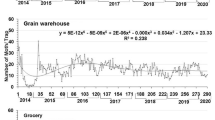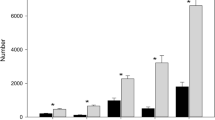Abstract
Since written information about the appearance of mothsEphestia elutella, E. cautella, E. kuehniella, andPlodia interpunctella which are harmful to stored products, is somewhat limited and uncertain, investigations into the appearance of the four species of moths out of doors, were carried out in 1982 and 1983 in Berlin (West) and in the Brunswick area (Lower Saxony) in 1984, using “Biotrap®” as bait in the traps. In both of the investigation areas male moths of all types appeared in the inner city zone (the numbers of the moths caught in Berlin are as follows, starting with the largest group:P. interpunctella, E. kuehniella, E. elutella, E. cautella). On the outskirts of both cities and in their park-like areas as well as in the rural countryside surrounding Brunswick,E. cautella was missing from the traps, probably because there is little or nothing there which is liable to infestation (nuts and cocoa beans) and which might give rise to the open-air appearance of the moths. In specially baited traps (pheromone and broken almonds) and in the vicinity of heavily infested objects, a very small number of female moths was also caught. The results of all investigations show that moths which are harmful to food supplies, are to be found out of doors.
The well-founded assumption that they might reinfest appropriate goods should be taken into consideration with respect to storage, especially since it has hitherto been taken for granted that an infestation can only arise from the storage of infested products.
Zusammenfassung
Da Angaben über ein Freilandauftreten der vorratsschädlichen MottenEphestia elutella, E. cautella, E. kuehniella undPlodia interpunctella in der Literatur recht spärlich und unsicher sind, wurden mit Hilfe der Biotrap®-Lockstoffalen in den Jahren 1982 und 1983 in Berlin (West) und 1984 im Braunschweiger Raum (Niedersachsen) Untersuchungen zum Auftreten der vier Mottenarten außerhalb von Gebäuden durchgeführt. In beiden Untersuchungsgebieten traten im innerstädtischen Bereich mänmliche Falter aller Arten auf (Rangfolge der Fangzahlen in Berlin:P. interpunctella, E. kuehniella, E. elutella, E. cautella; Rangfolge der Fangzahlen in Braunschweig:E. kuehniella, P. interpunctella, E. elutella, E. cautella). Am Stadtrand und in parkartigen Regionen beider Städte sowie in Braunschweigs dörflichem Umland fehlteE. cautella in den Fallen, weil höchstwahrscheinlich keine oder nur wenige Befallsherde (Nüsse und Rohkakao) vorhanden sind, von denen ein Freilandauftreten ausgehen könnte. In speziell beköderten Fallen (Pheromon+Mandelbruch) und in der Nachbarschaft stark befallener Objekte wurden in geringer Anzahl auch Weibchen gefangen. Alle Untersuchungsergebnisse zeigen, daß vorratsschädliche Motten im Freiland vorkommen. Die begründete Annahme, von ihnen könne ein Neubefall geeigneter Objekte ausgehen, sollte bei der Lagerhaltung berücksichtigt werden, zumal man bislang davon ausging, daß ein Befall nur durch Einlagerung infizierter Ware entsteht.
Similar content being viewed by others
Literaturverzeichnis
Bommer, H.; Reichmuth, Chr., 1980: Pheromone der vorratsschädlichen Motten (Phycitinae, speziell MehlmotteEphestia kühniella Zeller) in der biologischen Schädlingsbekämpfung: Bibliographie und Versuche. Mitt. Biol. Bundesanst. Land-Forstw. Berlin-Dahlem, H. 198.
Burghardt, G., 1982: Ein Prognosesystem mit Pheromonen für den Obstbau. Rhein. Monatsschr. Gemüse Obst Zierpfl.70 (4), 154–156.
Knoche, C., 1972: Einschleppung und Flugzeiten von Kakaomotten. Gordian1472, 11–15.
Roesler, U., 1966: Die deutschen Arten desHomoeosoma-Ephestia-Komplexes. Mitt. Münchner Entomol. Ges.56, 104–160.
Schulten, G. G. M.;Kuyken, W., 1967: “Warehouse moths” and some tropical products stored in the Netherlands. Mededel. Rijksfac. Landbouwwetenschap. Gent32, 584–592.
Steuer, H., 1966: Die Schmetterlinge von Bad Blankenburg (Thüringer Wald) II. Teil Pyraloidea. Deutsche Ent. Z., N. F.,13.
Steuer, H., 1984: Die Schmetterlinge von Bad Blankenburg IV. Teil (Lepidoptera). Deutsche Ent. Z., N. F.,31, 91–152.
Zacher, F.;Lange, B., 1964: Vorratsschutz gegen Schädlinge. Verlag Paul Parey, Berlin und Hamburg.
Author information
Authors and Affiliations
Additional information
Mit 4 Abbildungen und 3 Tabellen
Rights and permissions
About this article
Cite this article
Wohlgemuth, R., Reichmuth, C., Rothert, H. et al. Auftreten vorratsschädlicher Motten der GattungenEphestia undPlodia außerhalb von Lägern und lebensmittelverarbeitenden Betrieben in Deutschland. Anz. Schadlingskde., Pflanzenschutz, Umweltschutz 60, 44–51 (1987). https://doi.org/10.1007/BF01903186
Issue Date:
DOI: https://doi.org/10.1007/BF01903186




